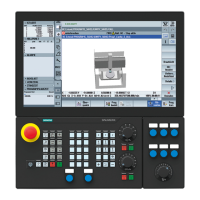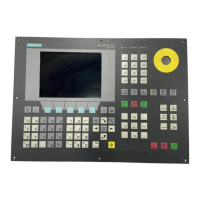Detailed Description
2.4 Protection zones
Axis Monitoring, Protection Zones (A3)
2-48 Function Manual, 08/2005 Edition, 6FC5397-0BP10-0BA0
Temporary release of protection zones
Protection zones can be enabled in JOG mode when:
1. the current position is within a protection zone (alarm active)
2. a motion is to be started on the protection zone limit (alarm active)
A protection zone is enabled when:
• a positive signal edge arrives at the PLC interface "Temporary enabling of protection
zones" (this enable resets the active alarm).
• if the axis then starts to move again into the same protection zone.
Start of the motion causes:
• the protection zone to be enabled
• the appropriate PLC interface signals "Machinespecific or channelspecific protection zone
violated" to be set.
• the axis to start moving.
The enabling signal is canceled if a motion is started that does not lead into the enabled
protection zone.
If the current position is located in other active protection zones or the limit for other
protection zones must be crossed with the motion that has been started, then alarms 10702,
10703 or 10706, 10707 are output. The PLC interface signal "Temporary enabling of
protection zones" can be set again to enable the protection zone for which an alarm is
output.
The enabling signals for the individual protection zones are still valid on switchover to
operating modes AUTOMATIC or MDA, and vice versa, the enabling signals of protection
zones that were output in AUTOMATIC and MDA remain valid.
If the end position is located outside the relevant protection zone the next time the axes in
the geometry system stop:
• the enabling signals of the individual protection zones are canceled
• the appropriate PLC interface signal "Machinespecific or channelspecific protection zone
violated" is reset.
2.4.7 Restrictions in protection zones
Restrictions in protection zone monitoring
No protection zone monitoring is possible under the following conditions:
• Orientation axes
• Protection zone monitoring for fixed machine-related protection zones with transmit or
peripheral surface transformation.
Exception: Protection zones defined with rotation symmetry around the spindle axis.
Here, no DRF offset must be active.
• Mutual monitoring of tool-related protection zones

